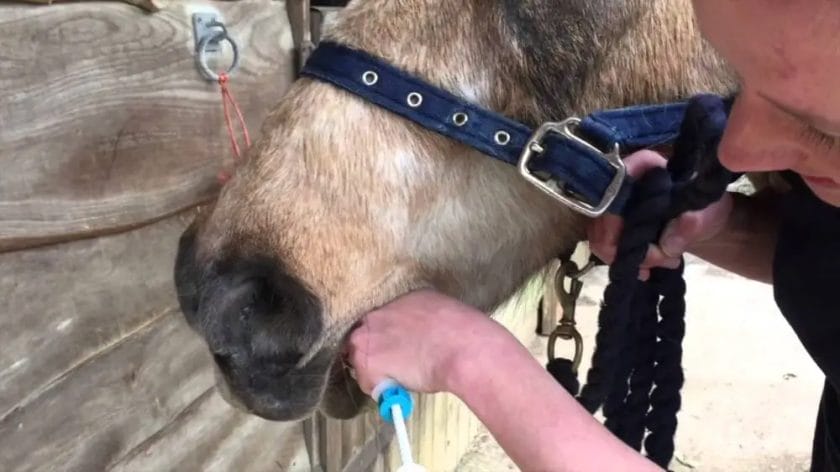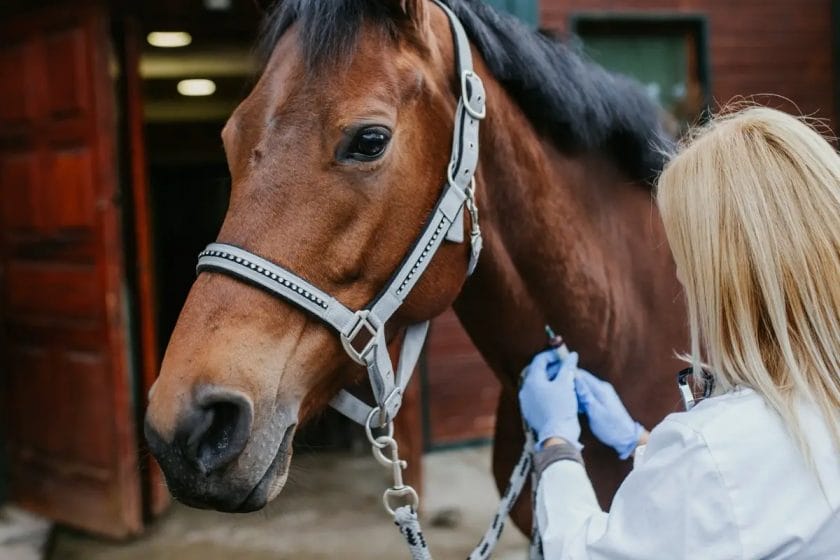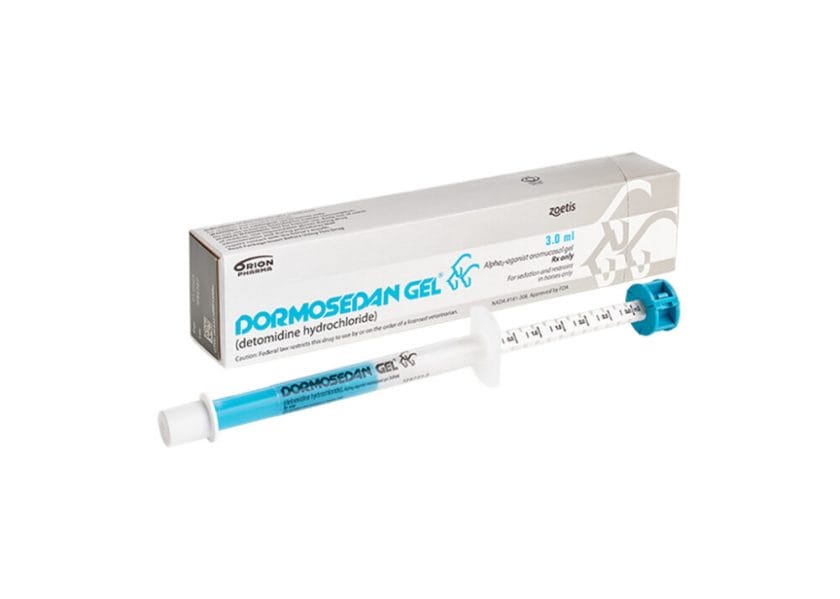If you’re wondering about the right dosage of Dormosedan Gel for your horse, it’s essential to consult with a veterinarian who can provide accurate guidance based on your horse’s specific needs.
Dormosedan Gel is a sedative and analgesic medication commonly used in equine medicine. It helps calm horses during medical procedures or when they need to be immobilized for certain treatments.
Administering the correct dosage of Dormosedan Gel is crucial for the safety and well-being of your horse. Your veterinarian will consider factors such as the horse’s age, weight, and overall health condition before determining the appropriate dosage.
Remember, self-administering medication without professional advice can be risky, so always seek expert guidance when it comes to dosing medications for your horse’s health and welfare.

Factors to Consider When Determining the Appropriate Amount of Dormosedan Gel for a Horse
Administering medication to horses requires careful consideration of various factors to ensure the correct dosage and avoid potential complications. When determining the appropriate amount of Dormosedan Gel to administer to a horse, several key factors need to be taken into account:
1. Weight of the Horse
The weight of the horse plays a significant role in determining the appropriate dosage of Dormosedan Gel. Generally, the dosage is based on the horse’s body weight, with a recommended range of 0.02 to 0.04 milligrams of Dormosedan per kilogram of body weight. It is important to accurately measure the horse’s weight and calculate the dosage accordingly.
2. Age and Health of the Horse
The age and overall health of the horse can also impact the dosage of Dormosedan Gel. Younger horses and those with compromised health may require lower dosages to minimize the risk of adverse effects. It is crucial to consider the horse’s health condition and consult with a veterinarian to determine the appropriate dosage.
3. Purpose of Administration
The purpose for which Dormosedan Gel is being administered also influences the dosage. Whether it is for sedation during veterinary procedures, transportation, or dental work, the dosage may vary. The veterinarian will consider the specific circumstances and the desired level of sedation required to determine the appropriate amount of Dormosedan Gel.
4. Individual Sensitivity
Each horse may react differently to Dormosedan Gel due to individual variations in sensitivity. Some horses may require a lower dosage to achieve the desired sedation level, while others may need a higher dosage. It is vital to monitor the horse’s response closely and adjust the dosage accordingly to ensure optimal sedation and safety.
5. Other Medications or Substances
If the horse is currently on any other medications or substances, it is essential to consider potential interactions with Dormosedan Gel. Some medications or substances may potentiate the effects of Dormosedan Gel, while others may reduce its effectiveness. Always inform the veterinarian about any ongoing treatments or supplements the horse is receiving.
6. Veterinary Guidance
Consulting with a veterinarian is crucial when determining the appropriate dosage of Dormosedan Gel for a horse. Veterinarians have the expertise and knowledge to assess the horse’s individual needs and provide accurate dosing recommendations. They can consider all relevant factors and guide horse owners on the correct administration of Dormosedan Gel.
In summary, determining the appropriate amount of Dormosedan Gel for a horse requires careful consideration of several factors, including the horse’s weight, age, health, purpose of administration, individual sensitivity, and any other medications or substances being used. It is essential to seek veterinary guidance to ensure safe and effective sedation while minimizing the risk of complications.

Potential Side Effects and Risks of Incorrect Dosage of Dormosedan Gel in Horses
Dormosedan Gel is a commonly used sedative for horses that helps calm them during various veterinary procedures. However, it is important to administer the correct dosage of Dormosedan Gel to avoid potential side effects and risks. Incorrect dosage can result in adverse reactions and may even pose a threat to the horse’s health.
1. Over-Sedation:
Administering an excessive amount of Dormosedan Gel can lead to over-sedation in horses. The horse may become excessively drowsy, weak, and uncoordinated. This can be dangerous, particularly if the horse is required to move or perform any strenuous activity. Additionally, over-sedation can increase the risk of the horse falling or injuring itself.
2. Respiratory Depression:
Another potential risk of incorrect Dormosedan Gel dosage is respiratory depression. The sedative properties of the gel can slow down the horse’s respiratory rate. If the horse is already suffering from any respiratory issues, such as asthma or allergies, the sedative effect can exacerbate the condition and lead to breathing difficulties. This can be life-threatening if not addressed promptly.
3. Gastrointestinal Issues:
Horses that receive an incorrect dosage of Dormosedan Gel may experience gastrointestinal issues. This can manifest as decreased appetite, colic symptoms, or even impaction. In severe cases, these gastrointestinal issues can result in significant discomfort and require veterinary intervention for proper management.
4. Increased Sensitivity to Noise and Stimulation:
Administering an incorrect dosage of Dormosedan Gel can cause horses to become overly sensitive to external stimuli, such as noise and movement. This heightened sensitivity can lead to increased anxiety, stress, and fear in the horse. It can also make handling and managing the horse more challenging, affecting the overall safety of both the horse and the handlers.
5. Prolonged Recovery:
Using an incorrect dosage of Dormosedan Gel can prolong the recovery period for the horse. If the horse receives an excessive dose, it may take longer for the sedative effects to wear off completely. This can delay the horse’s ability to resume normal activities, such as eating, drinking, and exercising. Prolonged recovery can also increase the risk of complications and other health issues.
6. Allergic Reactions:
In rare cases, horses may exhibit allergic reactions to Dormosedan Gel, even with the correct dosage. However, administering an incorrect dosage can increase the likelihood of an allergic reaction. Allergic reactions can range from mild skin irritations to severe anaphylaxis, a potentially life-threatening condition. It is crucial to monitor the horse closely after administering the gel for any signs of an allergic reaction.
In summary, administering the correct dosage of Dormosedan Gel is crucial to ensure the safety and well-being of horses. Incorrect dosage can lead to over-sedation, respiratory depression, gastrointestinal issues, increased sensitivity to stimuli, prolonged recovery, and allergic reactions. To mitigate these risks, it is important to consult with a veterinarian and follow their instructions for proper and safe administration of Dormosedan Gel.

Proper Measurement and Administration of Dormosedan Gel for Horses
Dormosedan Gel is a sedative commonly used in horses to facilitate various procedures such as dental work, sheath cleaning, and minor surgical procedures. It is important to administer the correct dosage of Dormosedan Gel to ensure the safety and well-being of the horse. In this section, we will discuss the proper techniques for measuring and administering Dormosedan Gel.
1. Reading and Understanding the Dosage
Before administering Dormosedan Gel, it is crucial to carefully read and understand the dosage instructions provided by the manufacturer. The dosage may vary based on the horse’s weight and the intended use of the sedative. Ensure that you have the correct dosage information and consult with a veterinarian if you have any doubts or concerns.
2. Measuring the Dosage
To measure the correct dosage of Dormosedan Gel, you will need a calibrated dosing syringe provided with the product. It is essential to use the syringe specifically designed for Dormosedan Gel, as other syringes may not provide accurate measurements.
Begin by removing the cap from the Dormosedan Gel syringe, ensuring that the plunger is fully depressed. Insert the tip of the syringe into the gel tube and gently pull back on the plunger to draw the gel into the syringe. The syringe is calibrated to show the appropriate dosage in milliliters (ml).
Be careful not to introduce air bubbles into the syringe while drawing the gel. If any air bubbles are present, gently tap the syringe to move the bubbles to the top and push the plunger slightly to expel them.
3. Administering the Dosage
Once you have measured the correct dosage of Dormosedan Gel, it is time to administer it to the horse. It is important to handle the syringe and gel with clean hands to prevent contamination.
Find a suitable area on the horse’s mouth for administration. The gel can be applied to the gums, the space between the cheek and teeth, or the tongue. Gently insert the syringe into the chosen area and push the plunger to release the gel. Take care not to administer the gel too quickly, as it may cause the horse to gag or choke.
After administering the Dormosedan Gel, remove the syringe from the horse’s mouth and allow the horse some time to swallow. Observe the horse closely for any adverse reactions or signs of sedation.
4. Monitoring the Horse
Once Dormosedan Gel has been administered, it is essential to closely monitor the horse. The sedative effects typically begin within 10-15 minutes and may last for several hours. Ensure that the horse is in a safe and quiet environment during this time to prevent any accidents or injuries.
Monitor the horse’s vital signs such as heart rate, respiration rate, and overall behavior. If any concerning signs or complications arise, contact a veterinarian immediately for further guidance.
5. Disposing of Unused Gel and Syringe
After administering the Dormosedan Gel, it is crucial to properly dispose of any unused gel and the syringe. Follow the instructions provided by the manufacturer for safe disposal of the gel tube and syringe. This helps prevent accidental ingestion or exposure to humans or animals.
In summary, properly measuring and administering Dormosedan Gel is essential to ensure accurate dosage and the well-being of the horse. Carefully read and understand the dosage instructions, use the provided dosing syringe, and administer the gel in a suitable area of the horse’s mouth. Monitor the horse closely and dispose of any unused gel and syringe appropriately. Always consult with a veterinarian for any specific dosage or administration concerns.
Tips for monitoring the horse after administering Dormosedan Gel to ensure proper sedation levels
Administering Dormosedan Gel to a horse is a common practice in veterinary medicine to achieve sedation for various procedures. However, it is essential to monitor the horse closely after administration to ensure that the sedation levels are appropriate and within the desired range. Here are some tips for effectively monitoring the horse after administering Dormosedan Gel:
1. Observe the horse’s behavior
After administering Dormosedan Gel, closely observe the horse’s behavior for any signs of sedation. Look for changes in the horse’s demeanor, such as a relaxed or drowsy appearance. The horse may exhibit slower movements and decreased alertness. It is important to note that the extent and duration of sedation can vary between horses, so it is crucial to monitor individual responses.
2. Assess vital signs
Check the horse’s vital signs regularly to evaluate its overall health and sedation level. Begin with measuring the horse’s heart rate, respiratory rate, and temperature. Changes in these vital signs can indicate the effectiveness and progress of sedation. Compare the values with the horse’s baseline measurements to identify any significant deviations.
3. Monitor the horse’s balance and coordination
When a horse is sedated, its balance and coordination may be impaired. Observe the horse’s gait and movements to ensure that it can navigate safely. Look for signs of stumbling, swaying, or difficulty walking. If the horse shows any instability, provide appropriate support and ensure a safe environment to prevent injury.
4. Evaluate the horse’s response to stimuli
Introduce gentle stimuli to assess the horse’s sensitivity and response level. This can include touch, sound, or visual cues. A sedated horse may have a reduced response to external stimuli or exhibit delayed reactions. Note any abnormal reactions or lack of response, as it may indicate excessive sedation or potential complications.
5. Maintain a record of sedation progress
Document the horse’s sedation progress by recording the time of administration, the dosage given, and the observed sedation level. This record can help veterinarians track the effectiveness of Dormosedan Gel and adjust future dosages accordingly. Additionally, it serves as a reference for future sedation procedures or medical treatments.
6. Seek veterinary assistance if necessary
If you have any concerns about the horse’s sedation level or notice unexpected reactions, it is crucial to seek veterinary assistance promptly. Veterinarians have the expertise to evaluate the situation, provide guidance, and intervene if necessary. They can also offer recommendations on monitoring techniques specific to your horse’s condition.
In summary, careful monitoring of a horse after administering Dormosedan Gel is essential to ensure appropriate sedation levels. By observing the horse’s behavior, assessing vital signs, monitoring balance and coordination, evaluating responses to stimuli, maintaining records, and seeking veterinary assistance when needed, you can ensure the safety and well-being of your horse during the sedation process.
FAQs
1. How much Dormosedan Gel should I give to a horse?
The recommended dosage of Dormosedan Gel for horses is 0.02 mg/kg, which is equivalent to 0.02 mL/kg. However, it is important to consult with a veterinarian to determine the appropriate dosage based on the horse’s weight and specific needs.
2. Can Dormosedan Gel be used for sedating horses during procedures?
Yes, Dormosedan Gel can be used for sedating horses during procedures such as dental work, sheath cleaning, or minor surgeries. It provides mild to moderate sedation and is typically administered orally onto the horse’s tongue.
3. How long does the sedative effect of Dormosedan Gel last in horses?
The sedative effect of Dormosedan Gel in horses typically lasts for about 2 to 4 hours. However, the duration may vary depending on the horse’s individual response and the dosage administered. It is important to monitor the horse closely during this period and ensure a safe environment.
Conclusion
In conclusion, when it comes to administering Dormosedan gel to a horse, it is crucial to follow the recommended dosage guidelines provided by a veterinarian. Giving the correct amount of Dormosedan gel is essential to ensure the horse’s safety and well-being during sedation. It is always recommended to consult with a professional before administering any medication to a horse. By doing so, you can ensure that the horse receives the appropriate dose of Dormosedan gel, minimizing the risk of adverse effects and promoting a successful sedation experience.
